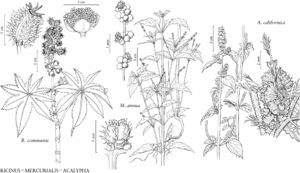Mercurialis annua
Sp. Pl. 2: 1035. 1753.
Herbs 1–6 dm. Stems erect, glabrous or glabrescent. Leaves: petiole 0.2–2 cm, with pair of small, usually stalked, rarely sessile, glands at apex; blade ovate to rhombic-ovate, 2.5–5.5 × 1–2.5 cm, base rounded to acute, apex acute to ± acuminate, both surfaces glabrate or glabrescent, margins ciliate. Staminate inflorescences: peduncle 2–5 cm, fertile portion 1–5 cm, 2–12 glomerate clusters of flowers separated by internodes to 1 cm. Pedicels: pistillate 0.5–1 mm, elongating to 0.5–7 mm in fruit. Staminate flowers: sepals broadly ovate, 1.5–1.8 mm; stamens 1 mm; filaments slender; anther locules subglobose. Pistillate flowers: sepals ovate, 1–1.5 mm; ovary densely hispid, hairs usually with bulbous bases. Capsules 2.5–3 × 3–4 mm, 3-lobed, hispid; sepals and columella persistent. Seeds gray or grayish, 2 × 1.5 mm, surface tuberculate. 2n = 16, 48, 64, 80, 96, 112 (Europe).
Phenology: Flowering and fruiting Feb–Nov.
Habitat: Disturbed areas, waste places, cultivated fields.
Elevation: 0–300 m.
Distribution
Introduced; Calif., Europe, w Asia, n Africa, Atlantic Islands (Macaronesia), also in South America (Argentina), s Africa, Pacific Islands (New Zealand)
Discussion
Mercurialis annua is one of two annual species in the genus; it is complex and morphologically variable, comprising diploids and polyploids, and with a variety of breeding systems including dioecious, androdioecious, and monoecious (M. Krähenbühl et al. 2002). Although several species and infraspecific taxa (for example, M. ambigua Linnaeus) have been recognized based on ploidy and sexual expression, these characters are not always correlated and there are no good morphological characters to distinguish taxa. The species is treated here in the broad sense following T. G. Tutin (1968) and R. Govaerts et al. (2000). Both dioecious and monoecious populations appear to be naturalized in California. The majority are dioecious and belong to diploid M. annua in the strict sense, while several recent collections are from monoecious populations and likely correspond to the polyploid M. ambigua.
Mercurialis annua is naturalized in the San Francisco Bay area (northern Bay area to Monterey County) and has been recorded there at least since the 1930s; it is becoming increasingly common as a weed in cultivated fields and waste areas. It has been collected recently in Riverside and Yolo counties, but it is unknown whether it is established in either county. There are old collections, mostly from the 1870s to 1920s, from eastern Canada (New Brunswick, Nova Scotia, Ontario, Quebec) and the eastern United States (for example Alabama, Delaware, Florida, Maryland, Massachusetts, New Jersey, New York, Ohio, Pennsylvania, South Carolina), but it has not been collected recently in eastern North America and appears not to be established. These old collections appear to be ballast waifs—the majority are from coastal areas or shores along inland shipping routes with a habit recorded as on ballast or in waste areas in the vicinity of ports. There are several old collections (early 1900s) and one recent collection (Lane County, weed in garden) from Oregon, but there is no evidence that it has become naturalized there.
Selected References
None.
Lower Taxa
"elongating" is not a number."connate" is not a number. "distinct" is not a number.
